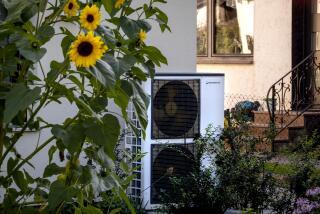Edison amps up program to cut electricity demand at peak times
As the Southland braces for the usual end-of-summer swelter, Southern California Edison isn’t working up a sweat about keeping the lights on even though its nuclear power plant has been permanently closed.
Partly that’s because Edison employees have been hustling for months to promote the Rosemead utility’s programs to tempt residential and business customers into shutting down air conditioning or other operations when electricity demand is high.
In exchange, customers get relief on their power bills through credits or rate discounts.
“It’s not a no-brainer,” said Kevin Wood, manager of Edison’s tariff programs and services. “But it’s giving up [control] for a short period, and it pays.”
In the absence of the San Onofre Nuclear Generating Station, Edison has gained attention for its efforts to line up new power supplies and for the controversy over who should pay for the substitute electricity and other costs — ratepayers or shareholders of the utility’s parent, Edison International.
An important tool in meeting customers’ demand for power is curbing use by homes and businesses at peak times.
Wood said the utility’s ongoing campaign to reduce peak energy use would help stave off blackouts while Edison and the state’s energy officials figure out a long-term plan.
The so-called demand response programs focus on summer months. San Onofre’s shutdown only heightened the potential threat of power shortages from extreme heat and wildfires, which can cause transmission lines to fail.
San Onofre was capable of generating 2,200 megawatts, or enough to serve 1.4 million average homes. Edison estimates that residents and businesses enrolled in its demand response programs could drop their electricity use by 1,300 megawatts combined on a given summer afternoon.
Since the statewide energy crisis of 2000-01, the menu of initiatives has expanded for businesses and homeowners willing to cut electricity use. Most programs follow a format in which customers are warned of upcoming “events” when they will be asked to reduce electricity use or have their air conditioning shut off from afar.
Participants usually have the opportunity to opt out of individual events.
Only two programs don’t allow that leeway; both give Edison remote access to shut off electricity to agricultural pumping equipment or commercial air conditioning systems during critical periods. Customers in these programs receive “courtesy alerts” by text, automated phone message or email about an hour before the shut-off.
Incentive amounts for the programs vary.
“They’re just so dependent on how much load a customer has to drop, and how much they’re willing to drop,” Wood said. But, she added, “some customers are able to earn up to 15% of their monthly bill.”
The air conditioner program grants monthly bill credits of up to $250 for businesses and $200 for homes.
Shut-offs have faced resistance, though.
During the energy crisis, the state’s Independent System Operator called for repeated interruptions. The frequent slashes in electricity started to affect operations at schools, hotels, stores and hospitals. Many threatened to quit.
In subsequent years, Edison sent smart meters to its commercial and industrial customers with demand larger than 200 kilowatts and adopted rates that change based on the time of day.
In 2009, those customers defaulted to the critical peak pricing program, which charges higher rates between 2 and 6 p.m. during critical peak pricing events. Customers are asked to reduce consumption, and during the summer earn credits on their monthly bills.
The critical peak pricing program has the second-highest enrollment of Edison’s options for commercial customers, totaling 3,237 accounts as of June.
That’s a slight increase from November, when the state Public Utilities Commission ordered Edison to adjust its programs to help deal with the hole left by San Onofre.
“From that [evaluation], we saw some programs didn’t work,” said Edward Randolph, director of the commission’s energy division. “We’ve accounted for that this summer. One of the biggest issues was that utility forecasting was a little overambitious. They expected more megawatts than we got.”
All but two of Edison’s demand response programs underperformed last summer. The utility reported an average reduction of 184 megawatts during 23 events in its residential summer discount plan, well below the average 280 megawatts it had forecast. As for critical peak pricing, the average reduction during 12 events was 37 megawatts instead of the 50 that utility officials had hoped for.
This summer, utility officials and supervising agencies said, Edison’s revamped load-reduction programs should help provide enough of a buffer, come what may in energy demand.
“If we’re talking about this summer,” Randolph said, “they have more than what is required under all planning margins.” Randolph said the utility had shown the commission it would be able to supply 115% of its forecasted peak load.
Edison expects this summer’s peak demand to be a little above last year’s 21,821-megawatt high, but there’s no telling whether use will surpass the all-time high of 22,300 megawatts in 2007.
Wood sounded sure the utility could handle the lofty demand just fine. “We’ve got it under control,” she said.






